Discover 11 hidden attractions, cool sights, and unusual things to do in Przemyśl (Poland). Don't miss out on these must-see attractions: Krasiczyn Castle, Przemyśl Cathedral, and Przemyśl Castle. Also, be sure to include Cathedral of St. John the Baptist in your itinerary.
Below, you can find the list of the most amazing places you should visit in Przemyśl (Subcarpathian).
Table of Contents
Krasiczyn Castle
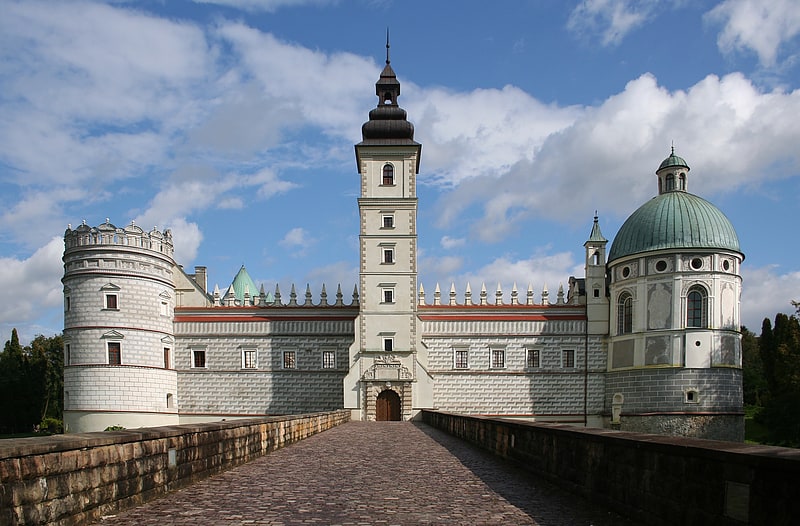
Also known as: Zamek w Krasiczynie
Hotel in Krasiczyn, Poland. Krasiczyn Castle is a Renaissance castle à la fortezza in Krasiczyn, southeastern Poland. It stands on a lowland at the right bank of the San River, along the Przemyśl-Sanok route and some 10 kilometres southwest of Przemyśl.
Across the centuries, the castle has belonged to several noble Polish families, and was visited by many Polish kings.
Together with a picturesque garden, it now belongs to the Industrial Development Agency (Polish: Agencja Rozwoju Przemyslu S.A.).[1]
Address: Krasiczyn 179, 37-741 Krasiczyn
Przemyśl Cathedral

Also known as: Bazylika archikatedralna Wniebowzięcia Najświętszej Maryi Panny i św. Jana Chrzciciela w Przemyślu
Cathedral in Przemyśl, Poland. The Cathedral of Przemyśl officially the Cathedral Basilica of the Assumption of the Blessed Virgin Mary and St. John the Baptist in Przemyśl is a Roman Catholic cathedral in Przemyśl, Poland. It is the main church of the Archdiocese of Przemyśl, located at the Cathedral Square in the Old Town.[2]
Address: Zamkowa 3, 37-700 Przemyśl
Przemyśl Castle
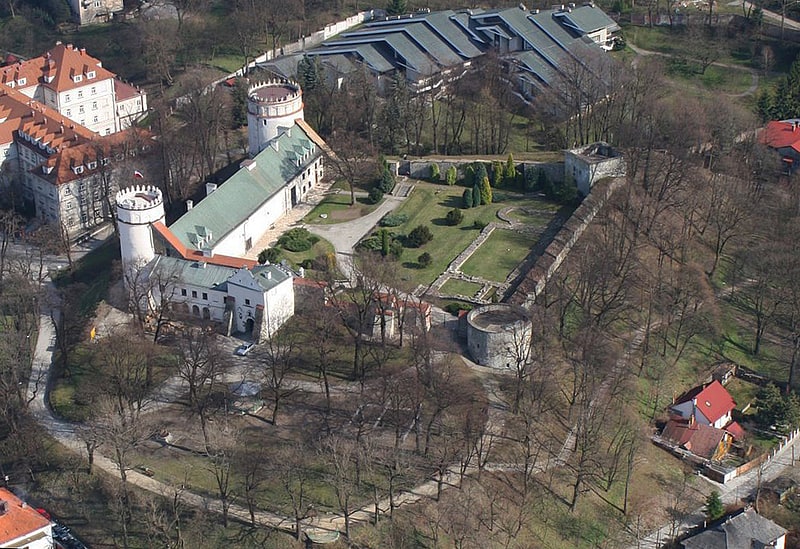
Also known as: Zamek Kazimierzowski
Museum in Przemyśl. Przemyśl Castle or Casimir Castle is a Renaissance castle in Przemyśl, Poland, located on the Castle Hill, which rises to a height of 270 metres above sea level and 70 meters above the city and the San River.[3]
Address: Aleja 25 Polskiej Druzyny Strzeleckiej 1, Przemyśl
Cathedral of St. John the Baptist
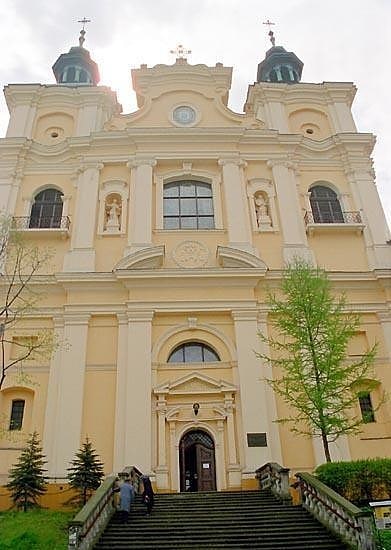
Also known as: Sobór św. Jana Chrzciciela w Przemyślu
Catholic cathedral in Przemyśl, Poland. The Greek Catholic Cathedral of St John the Baptist in Przemyśl serves as the mother church of the Ukrainian Greek Catholic Archeparchy of Peremyshl-Warsaw. It is located at the Ulica Katedralna in Przemyśl, in southern Poland.
The church was built in the 17th century by the Jesuit order and dedicated to St. Ignatius. After Przemyśl fell under Austrian rule and the suppression of the order in 1773 it slowly fell into ruins and in 1820 was closed by Austrians and turned into a storehouse. With the gradual democratization of region in the second half of the 19th century plans appeared to restore the church, finally carried out in 1903 and in 1904 the former Jesuit church was reconsecrated in 1904 as Sacred Heart of Jesus. After World War II it served as a garrison church and also offered a weekly Mass in the Byzantine Rite for Ukrainian Catholics whose church had been closed by the communist government.
In 1991 the church was subject of a controversy, when the Roman Catholic Church (with personal oversight by pope John Paul II) decided to donate the building to the Greek Catholic population in Przemyśl, to serve as the cathedral of the Archeparchy of Peremyshl-Warsaw in place of the Carmelite Church, which after World War II has returned to the Carmelites. After this decision, local Polish nationalists blockaded the entrance to the Greek Catholics and organized a hunger strike. After several weeks of debate and negotiation they desisted.[4]
Address: 2 Błogosławionego biskupa Jozafata Kocyłowskiego, Przemyśl
Carmelite Church
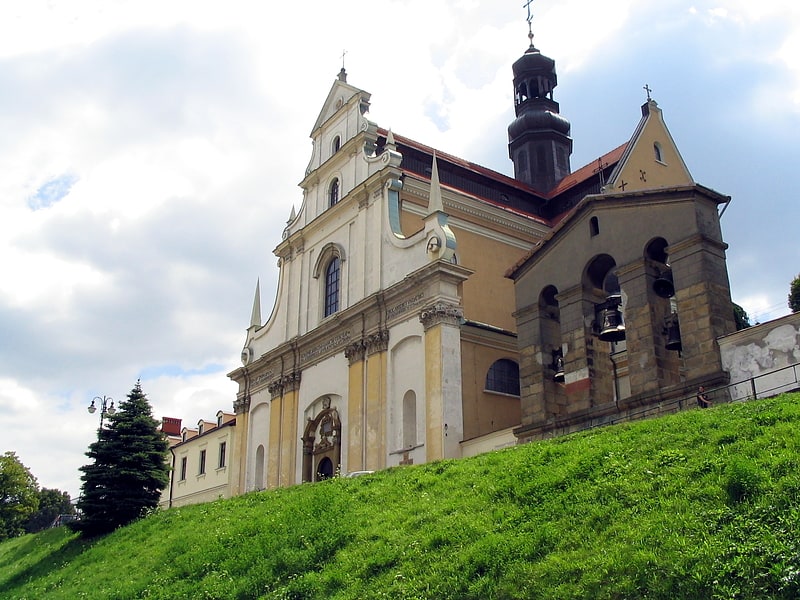
Also known as: Kościół i klasztor Karmelitów bosych w Przemyślu
Convent in Przemyśl, Poland. The Carmelite Church of St. Theresa is a late-Renaissance church in the city of Przemyśl, in the Subcarpathian Voivodship in southern Poland.[5]
New Synagogue
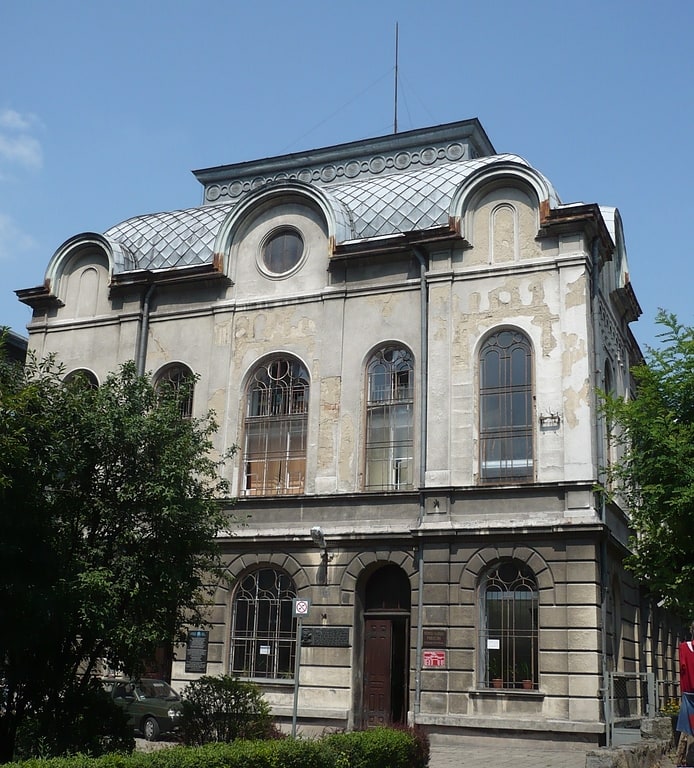
Also known as: Nowa Synagoga w Przemyślu
Synagogue in Przemyśl, Poland. The Przemyśl New Synagogue, also known as the Scheinbach Synagogue, was an Orthodox synagogue in Przemyśl, Poland. Since World War II, the synagogue, which is still standing, has been used as the Ignacy Krasicki Przemyśl Public Library.[6]
Address: Słowackiego 15, Przemyśl
Muzeum Dzwonów i Fajek
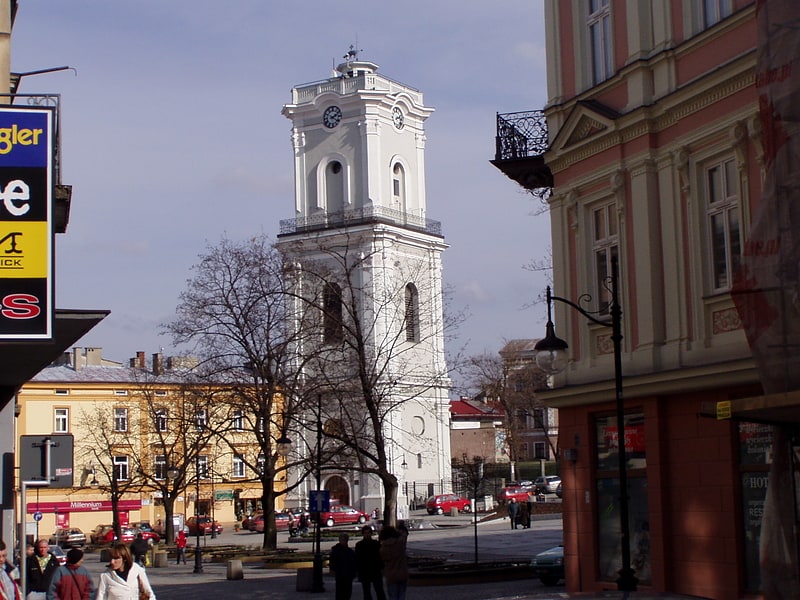
Przemyśl clock tower - a tower standing in the center of Przemyśl, at 3 Vladycze Street.
The tower was erected in 1775-1777 by the foundation of the Greek Catholic Bishop of Przemyśl, Athanasius Sheptytsky, as the bell tower of the future Greek Catholic cathedral. The cathedral was to replace an earlier brick church dating from the 16th century, which stood on the site of today's Primary School No. 11.
After the first partition of Poland, the construction of the cathedral began, and the investment was promised to be supported by the Empress Maria Theresa Habsburg. They only managed to demolish the old Orthodox church and build a magnificent late Baroque bell tower when the Empress died and the promises of funds were abandoned at the imperial court. This construction was never completed, and after the dissolution of the Carmelite monastery in 1784, the Greek Catholic diocese received ownership of the Carmelite church of St. Theresa, to be used as a cathedral council.
The 34-meter-high belfry, topped with a viewing gallery and equipped with a tower clock (this is where the current name of the tower comes from), over time began to serve as a watchtower, used by the fire department as an observation point. In 1850 it was partially destroyed by a fire, which consumed the late Baroque helmet. Restored in 1925, 1959-1960 and 1989-1990.
Since 1996 it has been adapted to the Museum of Bells and Pipes, a branch of the National Museum of Przemysl.
Object entered in the register of monuments under No. A-589 (06.06.1983).
Muzeum Narodowe Ziemi Przemyskiej
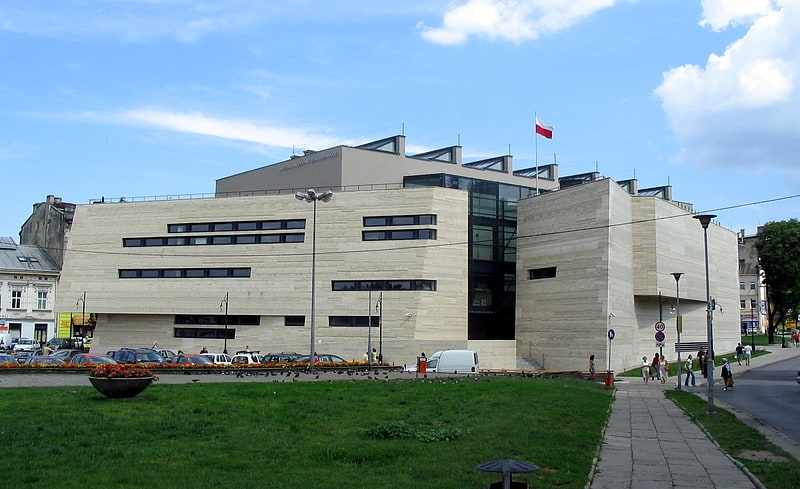
National Museum of the Przemysl Region in Przemyśl - a museum in Przemyśl, founded in 1909 on the initiative of local social activists as the Museum of the Society of the Friends of Learning in Przemyśl. The ceremonial opening of the first exhibition took place on April 10, 1910. The core of the collection was a private collection of Kazimierz and Tadeusz Osiński and numerous donations from the society.
In 1921, after joining the Union of Historical and Artistic Museums in Poznan, it adopted the name The National Museum of Przemysl, reactivated in 1984.
During the interwar period, the institution struggled with financial and space problems, changing its location several times. In 1945 the Museum took over the collection of the Ukrainian 'Strywihor' Museum, which had been requisitioned by the Polish authorities. After World War II, in 1946, the institution also received the magnificent building of the Greek Catholic bishopric at 3 Czackiego Square.
In 2008, construction of a new building for the National Museum of the Przemysl Land was completed on the site where several dozen years ago there used to be Jewish buildings. The new building of the National Museum of the Przemysl Land, designed by KKM Kozień Architekci, was one of the Polish candidates for the 2009 Mies van der Rohe Award, a prestigious award given every two years by the Mies van der Rohe Foundation and the European Commission to the best European projects.
The museum's storehouses contain, among other things, extensive collections on Professor Rudolf Weigl's scientific work: elements of the institute's laboratory equipment, books and scientific journals with publications of scientific works and papers, photographs and newspapers with articles on Professor Weigl donated largely by Professor Stefan Krynski.
In May 2016, the Bunker Stage at the Museum's headquarters began its activities, presenting plays and concerts, meetings with artists, journalists and cultural people.
Tatarska Góra TV Tower

Also known as: RTCN Tatarska Góra
Tower in Przemyśl, Poland. Tatarska Góra TV Tower is an 86-meter steel tower, situated at the Tartar Mound in the area of Przemyśl, Poland that was built in the 1930s.[7]
Zasanie Synagogue
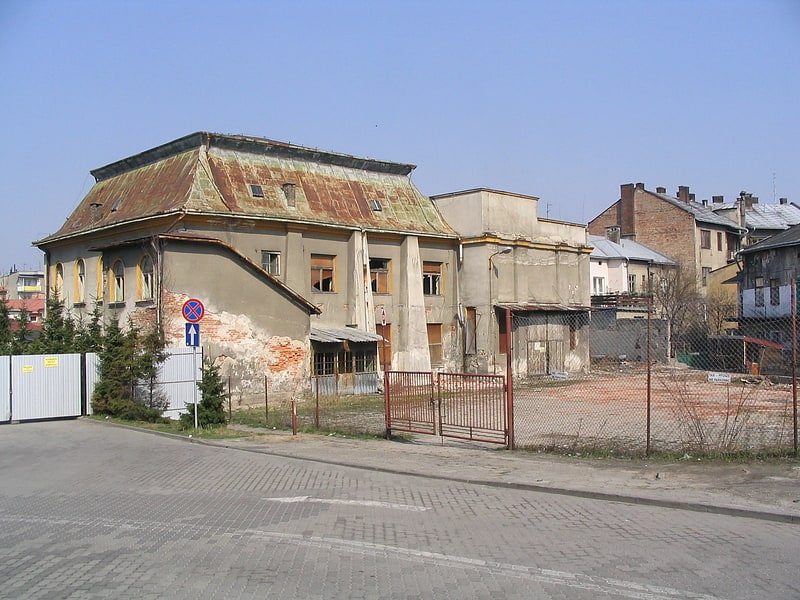
Also known as: Synagoga Zasańska w Przemyślu
Synagogue in Przemyśl, Poland. Zasanie Synagogue, located in Przemyśl, Poland, was the only synagogue in Przemyśl built on the western bank of the San River. It served as a house of prayer for 30 years until the Second World War. Today it is one of the two remaining synagogue buildings in Przemyśl. The other is the New Synagogue.[8]
Kościół Franciszkanów
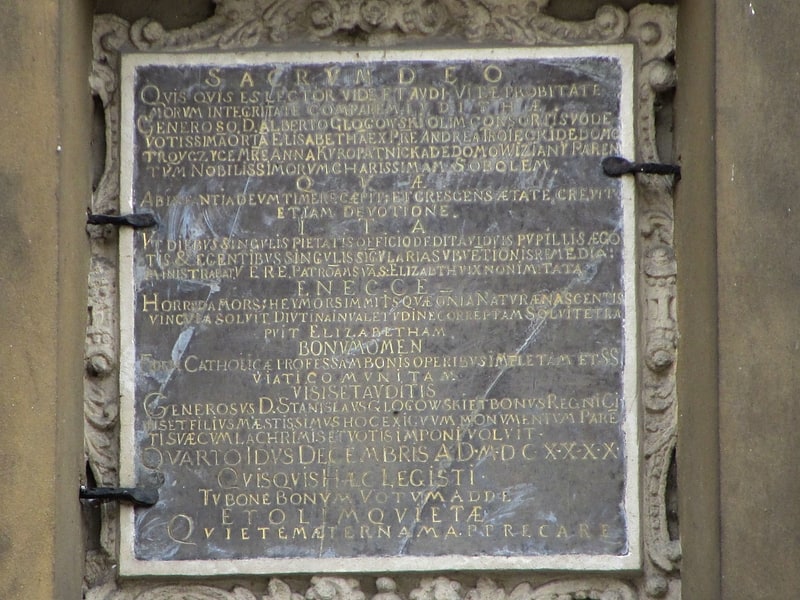
Church of St. Mary Magdalene and Our Lady Immaculate and the adjacent Franciscan monastery - a religious complex located in Przemyśl on Franciszkańska Street.
Address: 17 Serbańska, Przemyśl